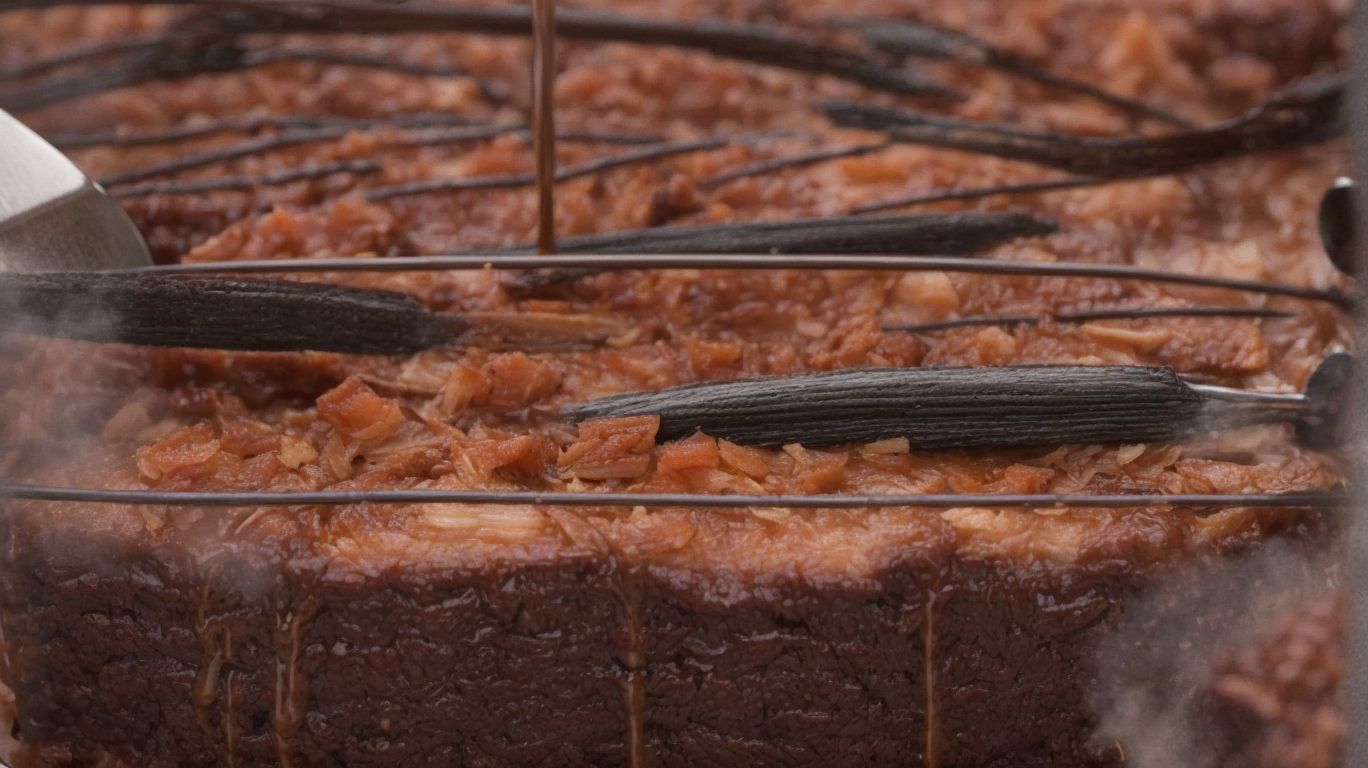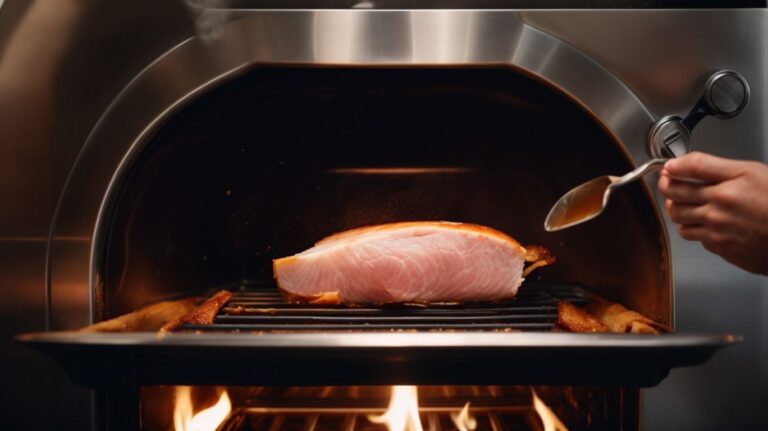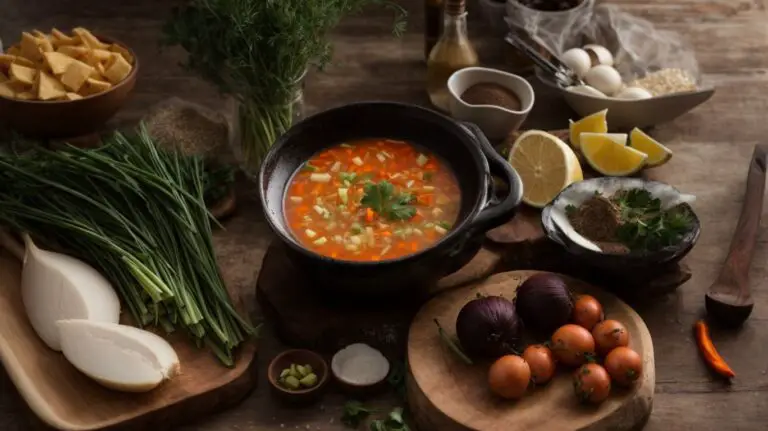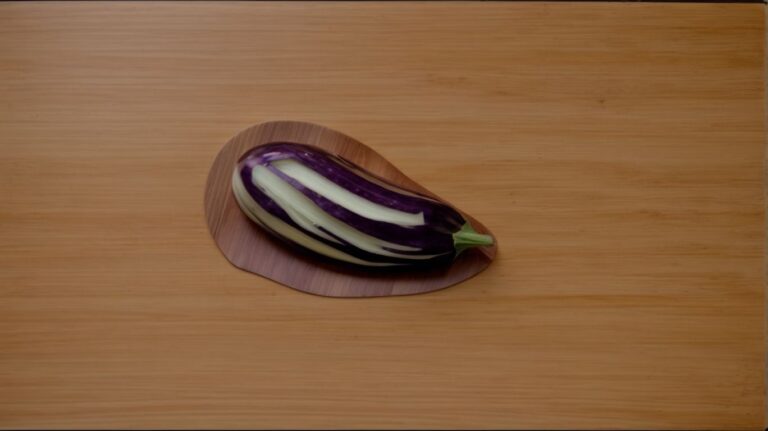How to Cook Brisket?
Looking to master the art of cooking brisket? This guide will cover everything you need to know about preparing, cooking, and serving this delicious cut of meat.
From choosing the right brisket to seasoning and cooking methods, we have you covered. Whether you prefer smoking, slow cooking, or oven roasting, we have tips to help you achieve the perfect brisket every time.
So, grab your apron and let’s get cooking!
Key Takeaways:
What Is Brisket?
Brisket, a popular cut of beef, is known for its rich flavor and tender texture, making it a favorite among meat lovers.
Known for coming from the lower chest area of the cow, brisket is characterized by its abundance of connective tissue, which breaks down during the slow cooking process to create that melt-in-your-mouth sensation.
Its versatility in the culinary world is immense, as it can be smoked, braised, roasted, or even barbecued to perfection. This cut’s unique flavor profile is often described as smoky, savory, and succulent, making it a centerpiece of traditional barbecue dishes.
What Are the Different Types of Brisket?
Brisket comes in two main cuts: the brisket flat, which is leaner and ideal for slicing, and the brisket point, known for its rich marbling and succulent texture.
The brisket flat, also referred to as the ‘first cut,’ is a long, rectangular piece of meat with a consistent thickness throughout. It is typically easier to find in stores due to its uniform shape and is favored by those looking to create neat slices for dishes like sandwiches or platters.
On the other hand, the brisket point, known as the ‘second cut,’ has a more irregular shape with more fatty marbling interwoven, providing a juicier and more flavorful eating experience.
Preparing Brisket for Cooking
Before cooking brisket, it’s essential to prepare it by applying a flavorful dry rub or marinade to enhance its taste and tenderize the meat.
Start by selecting a dry rub or creating your own blend of spices like smoked paprika, garlic powder, brown sugar, salt, and pepper.
Coat the brisket generously with the dry rub, making sure to cover all sides for maximum flavor penetration.
If you prefer marinating, you can combine ingredients like soy sauce, Worcestershire sauce, apple cider vinegar, and mustard for a tangy and savory profile.
Let the brisket sit in the marinade for at least a few hours or ideally overnight in the refrigerator to allow the flavors to infuse deeply into the meat.
How to Choose the Right Brisket?
Selecting the right brisket involves considering factors such as the cut of beef, with options like chuck beef or chuck roast offering different flavor profiles and cooking characteristics.
Chuck beef and chuck roast are popular choices for brisket due to their marbling, which enhances tenderness and flavor during cooking. The chuck beef, also known as the shoulder cut, contains connective tissue which breaks down slowly, making it ideal for slow-cooking methods like braising or smoking.
On the other hand, chuck roast, a versatile cut with rich marbling, works well for smoking as it retains moisture and produces succulent, melt-in-your-mouth brisket. Understanding the distinctions between these cuts can help you determine the best option based on your preferred cooking technique and desired end result.
How to Trim Brisket?
Trimming brisket involves removing excess fat caps and connective tissues to ensure even cooking and enhance the meat’s tenderness and flavor.
When trimming brisket, start by examining the surface of the meat for any thick layers of fat. Use a sharp knife to carefully slice off these fat caps while keeping the blade parallel to the surface to avoid removing too much meat.
Next, look for connective tissues such as silver skin or membrane. These tough tissues can be tough and chewy when left on the meat, so trim them off using the tip of your knife with short, precise cuts.
Be on the lookout for any hard, gristly sections or discolored areas that may affect the final dish’s taste and texture. These should be carefully removed to ensure a more uniform appearance and flavor.
How to Season Brisket?
Seasoning brisket can be done with a variety of spices, herbs, and homemade BBQ sauce to create a flavorful crust and enhance the overall taste of the meat.
In terms of seasoning brisket, the method used can significantly impact the final flavor profile. Dry rubs, marinades, and injections are popular ways to infuse flavor into the meat. Dry rubs typically consist of a mixture of spices such as paprika, garlic powder, onion powder, and cayenne pepper, while marinades involve soaking the brisket in a flavorful liquid. Injections, on the other hand, involve using a syringe to directly introduce the seasoning into the meat.
Cooking Methods for Brisket
Brisket can be cooked using various methods such as smoking, slow cooking, and oven roasting, each imparting a unique flavor profile to the meat.
In terms of smoking brisket, the process involves cooking the meat low and slow over indirect heat, typically using wood chips to infuse a rich smoky flavor. Slow cooking, on the other hand, is a method that requires extended cooking times at low temperatures, resulting in tender and juicy meat. Oven roasting, a more traditional approach, involves cooking the brisket in a closed environment, allowing the heat to circulate evenly around the meat for a consistent outcome. Each technique offers distinct advantages and can significantly impact the texture and taste of the final dish.
Smoking Brisket
Smoking brisket involves slow-cooking the meat in a smoker or grill, infusing it with aromatic wood smoke for a distinctive flavor and tender texture.
Choosing the right wood for smoking brisket is crucial for achieving that perfect balance of flavor. Common woods used include hickory, oak, mesquite, and fruit woods like apple or cherry. Each wood imparts a unique taste to the meat, so experimenting with different combinations can be an exciting journey for your taste buds.
Maintaining a consistent temperature during the smoking process is key. Utilizing a thermometer and adjusting the vents on your smoker to control the airflow can help you achieve that ideal slow-cooked tenderness.
Slow Cooking Brisket
Slow cooking brisket in a slow cooker results in tender, melt-in-your-mouth meat that can be easily shredded for sandwiches or tacos.
When cooking brisket using the slow cooker method, it is crucial to allow enough time for the meat to break down and become incredibly juicy and flavorful. Depending on the size of the brisket, the cooking time can range from 8 to 10 hours on low heat. This extended duration at a low, consistent temperature allows the tough connective tissues in the meat to slowly soften and transform into succulent, fork-tender bites.
To enhance the flavors, consider marinating the brisket overnight with a mix of spices, herbs, and a flavorful liquid like beef broth or red wine. Another tip for perfecting your slow-cooked brisket is to sear the meat in a hot skillet before placing it in the slow cooker. This caramelizes the surface, sealing in the juices and adding depth to the overall taste profile. As the brisket simmers away, the aroma will fill your kitchen, building anticipation for the tender result that awaits. Patience is key when it comes to slow cooking brisket, but the delicious end result is more than worth the time investment.
Oven Roasting Brisket
Oven roasting brisket is a convenient method that allows the meat to caramelize and develop rich flavors while cooking low and slow in the oven.
When oven roasting brisket, it’s essential to preheat the oven to a moderate temperature, typically around 300-325°F. This low and slow cooking process ensures that the meat becomes tender and juicy.
For optimal flavor, consider basting the brisket with a mixture of beef broth, spices, and a touch of honey or molasses throughout the cooking time. This helps keep the meat moist and adds complexity to the final dish.
To achieve that coveted caramelization on the exterior of the brisket, you can increase the oven temperature towards the end of the cooking process. This step will give the brisket a beautiful crust while keeping the interior juicy and flavorful.
Tips for Cooking the Perfect Brisket
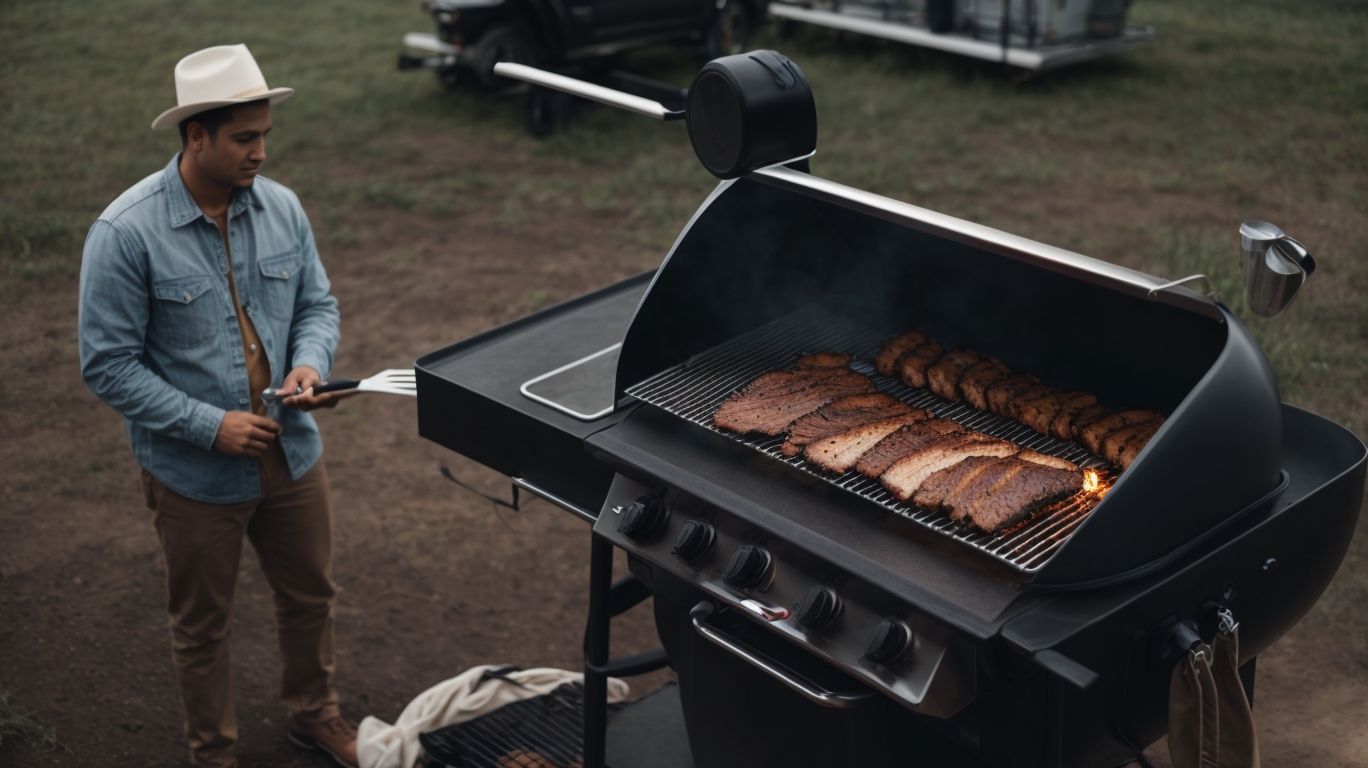
Credits: Poormet.Com – Larry Miller
To cook the perfect brisket, use a meat thermometer for accuracy, baste with homemade BBQ sauce for flavor, and let the brisket rest before serving to retain its juices.
When monitoring the temperature, aim for an internal temperature of around 195-205°F for that ideal tenderness.
Applying the BBQ sauce at the right intervals during smoking or baking can create a delicious caramelized crust, enhancing the overall taste.
Don’t rush the resting period; allow the brisket to sit for at least 30 minutes, covered, to allow the juices to redistribute and further tenderize the meat.
Choosing the Right Wood for Smoking
Selecting the right wood for smoking brisket can significantly impact its flavor, with options like hickory, mesquite, and applewood offering distinct smoke profiles.
Each type of wood brings a unique essence to the meat, determining whether it will have a robust, sweet, or spicy flavor.
Hickory, known for its strong, bacon-like aroma, pairs well with pork and beef.
Mesquite, with its intense and earthy flavor, is ideal for grilling red meats like steaks or ribs.
On the other hand, applewood provides a delicate sweetness, making it perfect for lighter meats such as poultry or fish.
Using a Meat Thermometer
A meat thermometer is essential for monitoring the internal temperature of brisket, ensuring that it reaches the desired level of doneness for optimal taste and texture.
When cooking a brisket, precision in temperature is key to achieving that perfect balance of tenderness and juiciness. The meat thermometer serves as your guiding tool throughout the cooking process, allowing you to track the gradual rise in temperature and ensure that the meat is cooked to the recommended safe level.
Proper probe placement is crucial; it should be inserted into the thickest part of the brisket without touching any bones for an accurate reading. By following the temperature guidelines provided with your meat thermometer, you can confidently prepare a flavorful and safe brisket for your next meal.
Letting the Brisket Rest Before Serving
Allowing the brisket to rest after cooking is crucial as it helps the meat retain its juices, resulting in a more tender and flavorful final dish when served.
Resting brisket also allows the meat fibers to relax, making it easier to slice without losing its natural juices. The duration of resting can vary depending on the size of the brisket; smaller cuts may only need 15-20 minutes, while larger ones could benefit from up to an hour of rest.
Choosing the appropriate resting method is equally important. Some prefer wrapping the brisket in foil to retain heat, while others opt for leaving it uncovered to avoid it becoming too moist.
Serving and Pairing Brisket
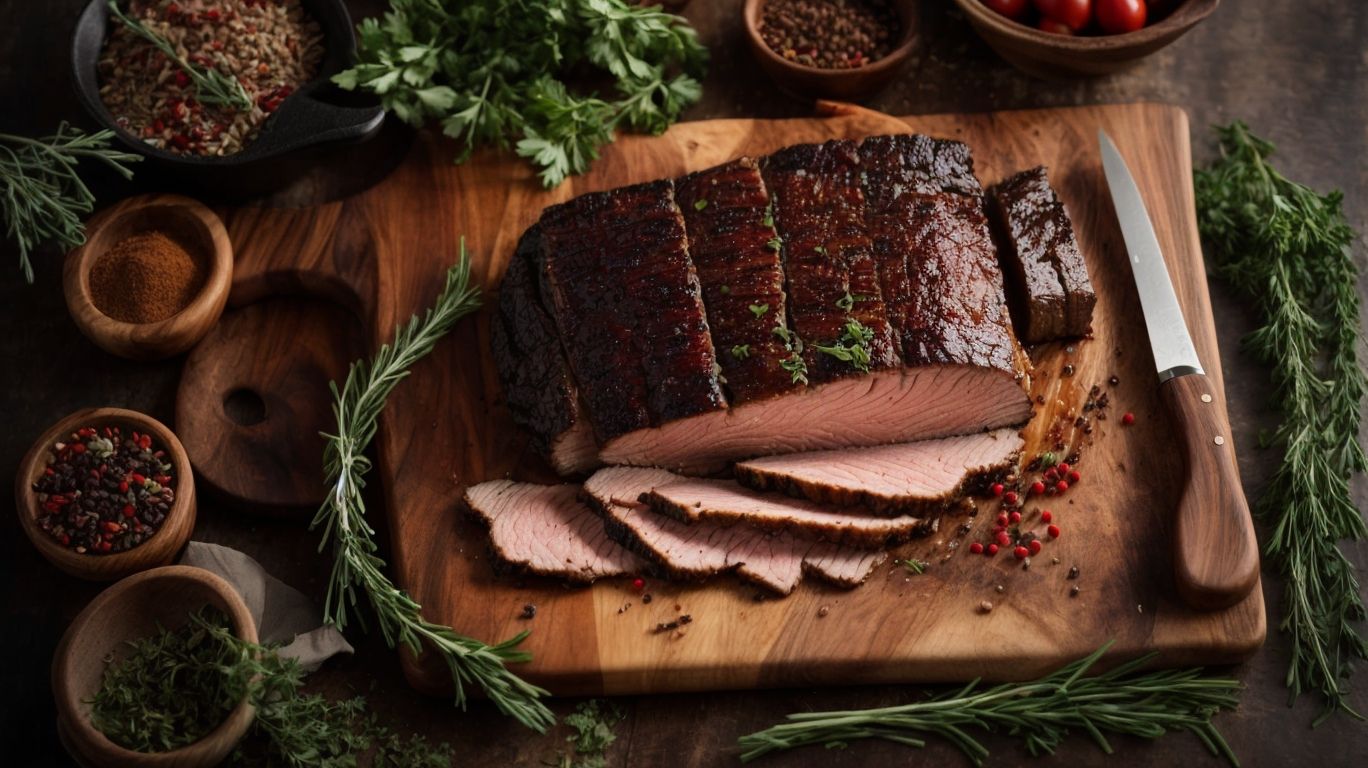
Credits: Poormet.Com – Harold Carter
In terms of serving brisket, slicing it against the grain ensures tenderness, pairing it with homemade BBQ sauce adds flavor, and serving it with complementary sides and wine enhances the dining experience.
For slicing brisket properly, it’s crucial to cut perpendicular to the meat fibers to maintain its juiciness and texture. Consider a variety of sauce accompaniments such as tangy vinegar-based sauces or rich, sweet molasses-based options to cater to different preferences. In terms of sides, classics like coleslaw, mac and cheese, or cornbread are popular choices that balance the richness of the meat.
For wine pairing, opt for robust reds like Cabernet Sauvignon or Zinfandel to complement the bold flavors of the meat. Alternatively, a chilled rosé or sparkling wine can provide a refreshing contrast to the hearty dish.
How to Slice Brisket?
To achieve the perfect slice of brisket, ensure to cut it against the grain to maintain tenderness and serve the slices in a visually appealing manner.
When slicing brisket, controlling the thickness of each slice is crucial to balance the tenderness and flavor of the meat. Aim for thin, even slices to ensure each bite is a delightful experience for your guests. Carving the brisket with a sharpened, long slicing knife will make the process smoother and allow for clean cuts. Presenting the slices on a wooden cutting board or a decorative platter can elevate the visual appeal of the dish, making it even more enticing.
What Sides Go Well with Brisket?
Brisket pairs well with a variety of sides such as coleslaw, cornbread, and brisket sliders, offering a range of flavors and textures to complement the rich meat.
For a classic combination, consider serving the brisket alongside some tangy coleslaw – the crunchy freshness of the slaw complements the savory richness of the brisket perfectly. Another traditional choice is warm, buttery cornbread, which provides a delightful contrast to the meat’s smoky flavors. If you’re looking to impress your guests with a more modern twist, why not try creating some delectable brisket sliders – mini sandwiches filled with tender slices of brisket, topped with pickles or a zesty barbecue sauce.
Recommended Wine Pairings for Brisket
Pairing brisket with a robust red wine like Cabernet Sauvignon or Zinfandel can complement its beefy flavor and richness, creating a harmonious dining experience.
When selecting a wine to pair with brisket, consider the bold flavors of the meat and the rich, savory sauces often used in its preparation. The tannins in Cabernet Sauvignon can stand up well to the fatty richness of the brisket, while the jammy notes of Zinfandel can enhance its smoky qualities.
For those who prefer white wine, a Chardonnay with buttery undertones can also be a suitable pairing option, offering a different but equally delightful contrast to the meat.
Frequently Asked Questions
1. How to Cook Brisket: What is the Best Method?
The most popular method for cooking brisket is low and slow in the oven or on the grill. This allows the meat to become tender and juicy, developing a rich and smoky flavor.
2. How to Cook Brisket: What Temperature Should I Use?
For the best results, it is recommended to cook brisket at 225-250°F (107-121°C). This allows for a slow and even cooking process, resulting in a tender and flavorful brisket.
3. How to Cook Brisket: Should I Use a Dry Rub or a Marinade?
Both methods can result in a delicious brisket, but it ultimately comes down to personal preference. A dry rub will create a flavorful crust, while a marinade will infuse the meat with flavor from the inside out.
4. How to Cook Brisket: How Long Should I Cook It?
Depending on the size of the brisket, it can take anywhere from 8-12 hours to cook at a low temperature. It is important to use a meat thermometer to ensure the internal temperature reaches 195°F (90°C) for a tender and fully cooked brisket.
5. How to Cook Brisket: Should I Wrap It in Foil?
Wrapping the brisket in foil, also known as the Texas crutch, can help speed up the cooking process and keep the meat juicy. However, this method can also result in a softer bark on the outside of the brisket.
6. How to Cook Brisket: Can I Use a Slow Cooker?
While a slow cooker is a convenient option, it is not recommended for cooking brisket. The low temperature is not ideal for developing a flavorful bark, and the meat can become too soft and lose its texture. Stick to using an oven or grill for the best results.

